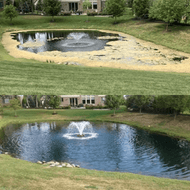
PondClear Study

The Challenge: Located in Auburn Hills, Michigan, two ponds (0.8 and 0.7 acres) were characterized by hypereutrophic conditions with cloudy water and late-season planktonic blooms.
The Solution: PondClear was applied on a biweekly basis throughout the summer to the 0.8-acre pond, leaving the 0.7-acre pond as the control. Water samples were collected and sent to an independent laboratory for analysis throughout the summer.
The Results: The turbidity of the pond being treated reduced consistently throughout the summer, while the control suffered the same yearly fate of cloudy, discolored water. PondClear decreased turbidity by 95% in 16 weeks.
Water Clarity Study - Using PondClear Packets
Application: Auburn Hills, Michigan
Airmax PondClear Packets
Abstract:
Trevor Henderson, Airmax Aquatic Biologist
The retention ponds of southeast Michigan are plagued with turbid, stagnant, nutrient-rich waters that are breeding grounds for pests, algae, and other harmful biologics. These hypereutrophic ponds result from a highly urbanized, swamp-filled environment and a mostly concrete, impermeable surface. Storm waters carry large organic debris and nutrients, resulting in an unbalanced, cloudy, murky body of water. In this environment, algae blooms proliferate and foul odors arise, causing major recreational issues. This was the case for two retention ponds which Airmax was tasked with clearing up through treatments with PondClear Packets, which contain a mix of beneficial aerobic bacteria and PRx, a phosphate binder. At the beginning of summer 2020, both ponds measured between 20 and 30 Formazin Attenuation Units (FAU) of turbidity, with a Secchi disk reading of approximately 3 inches. By the end of 16 weeks of treatment with PondClear Packets, the treated pond showed a nearly 95% decrease in turbidity while the control pond showed a nearly 50% increase in turbidity. The treated pond had additional positive results, generating a nearly 76% reduction in Free Reactive Phosphates suspended in the water column.
Introduction:
As the heart of suburban Michigan, the southeast corner of the state is defined by a mostly impermeable substrate layer (mostly developed commercial and residential lands). This impermeable surface causes rainwater flooding, which its infrastructure is built around, utilizing large retention ponds, intricate storm drain systems, and deep ditches aside from all roadways. All this rainwater transportation resulted in immense particulate volume being transported, as well. While the heavily laden water eventually ends up in the notoriously murky Lake St. Clair, it spends much time traveling through retention ponds and causing issues upstream. Highly turbid water can stifle pond-growing macroalgae species such as Chara spp. and bottom-rooting submerged weeds. These plants and algae are crucial to fish lifecycles, piscivores, birds, and nutrients cycling out of the water bodies. Without beneficial plants and algae, things such as Harmful Algae Blooms (HAB), and other nuisance filamentous algal growths can take over a pond, producing toxins and odors and decreasing the recreational value of the water body.
A small community in Auburn Hills, Michigan, approached Airmax Inc. about their two retention ponds (measuring 0.8 acres and 0.7 acres, with average depths of approximately 2.75 feet) that were plagued with issues. Airmax Inc. agreed that their focal issue was the pond's turbidity, which created a cascading effect of other issues. To address the turbidity challenges, PondClear Packets were chosen to be applied to one pond, and the other pond was used as a control pond. PondClear Packets consist of a blend of beneficial aerobic bacteria (known strains) designed to break down larger organics and digest particles to settle inorganic molecules or safely release atmospheric components. PondClear Packets also include PRx, a phosphate-binding product that binds some of the released nutrients from organic digestion.
Methods:
The 0.8-acre pond was treated with PondClear Packets, applied on a biweekly basis for 16 weeks during the peak growing season, from the beginning of June to the end of September 2020. The 0.7-acre pond was used as the control. Representative water samples were pulled initially and monthly through the end of the study, and samples were taken to an independent laboratory for turbidity and Free Reactive Phosphate analysis.
Results:
Average Turbidity (FAU) as read from representative water samples from both ponds, is shown below. Testing was performed by an independent laboratory using Absorptometric Analysis and measured using FAU (Formazin Attenuation Units).

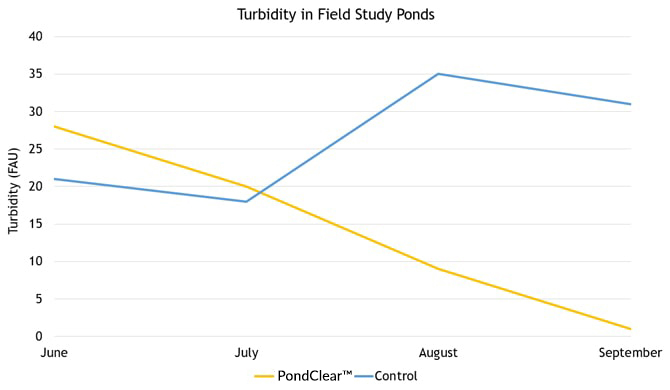
Soluble Reactive Phosphate (SRP) was measured at the beginning and end of the study in the treated and control pond, and the percent reduction is shown below. Testing was performed at an independent laboratory using the Ascorbic Acid Method.
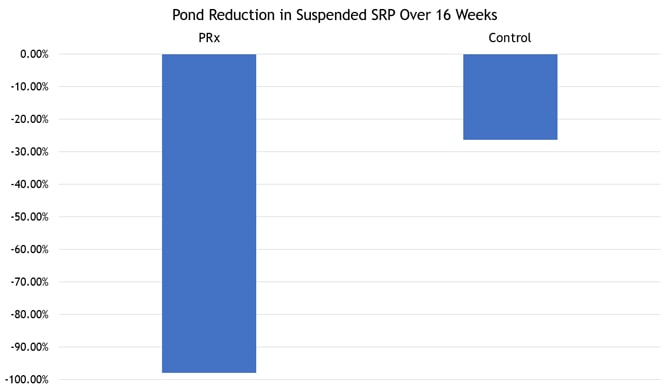
Before Treatment
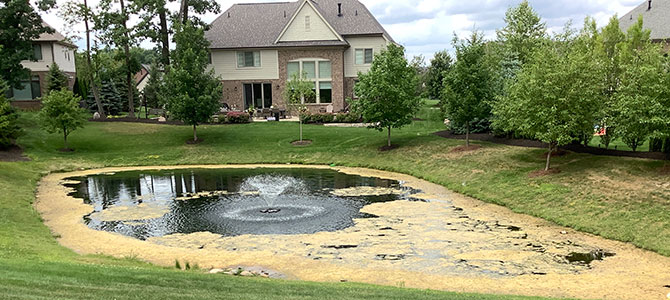
After Treatment
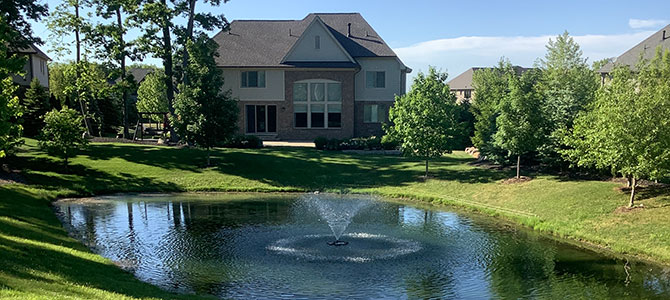
PondClear was applied in June, and within the first week, results were seen and customers reported high satisfaction.
Discussion:
The PondClear Packets significantly improved the suspended ecosystem in the treated pond, with significant reductions in turbidity and Free Reactive Phosphate (FRP). Turbidity was reduced by nearly 95% in the treated pond, allowing an increased photic zone with more surface area for native, submerged plants to grow. The clear water was more visibly attractive, but the reduction in bioavailable nutrients followed suit with over a 76% reduction in algae-causing FRP. This FRP reduction was due to the PRx component in the PondClear Packet binding and sinking the FRP in an inactive state to the bottom of the pond. This bound particulate is permanently locked up and removed from the food chain, no longer providing nutrients to other algae blooms.
Conclusion:
At the end of the study, the customers were very pleased with the results, as neighborhood residents were able to enjoy the pond once more. The customers opted for all their ponds to be treated with PondClear Packets going forward. The pond ecosystem was successfully stabilized through the chemical treatments, combined with the beneficial bacteria digesting the killed algae and the phosphate binder preventing a recurring algae bloom.
PondClear Packets will continue to be applied to these retention ponds, and PondClear Packets are able to maintain similar retention ponds which have constantly inflowing nutrients.
